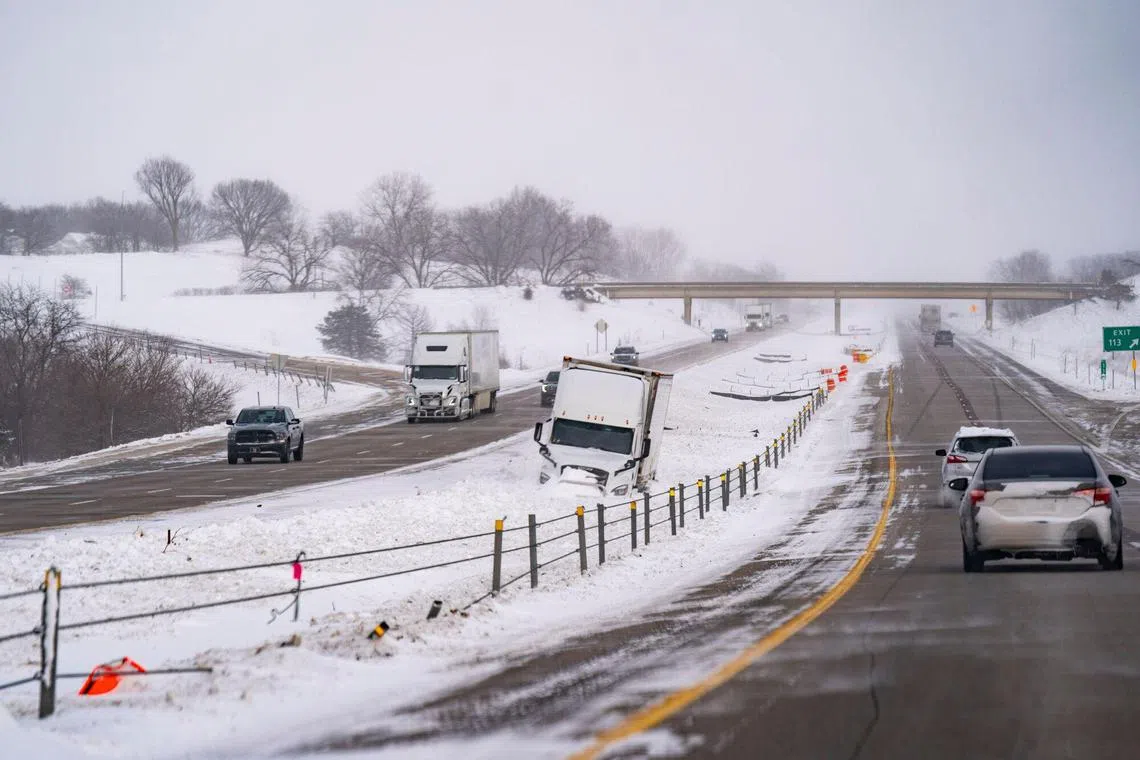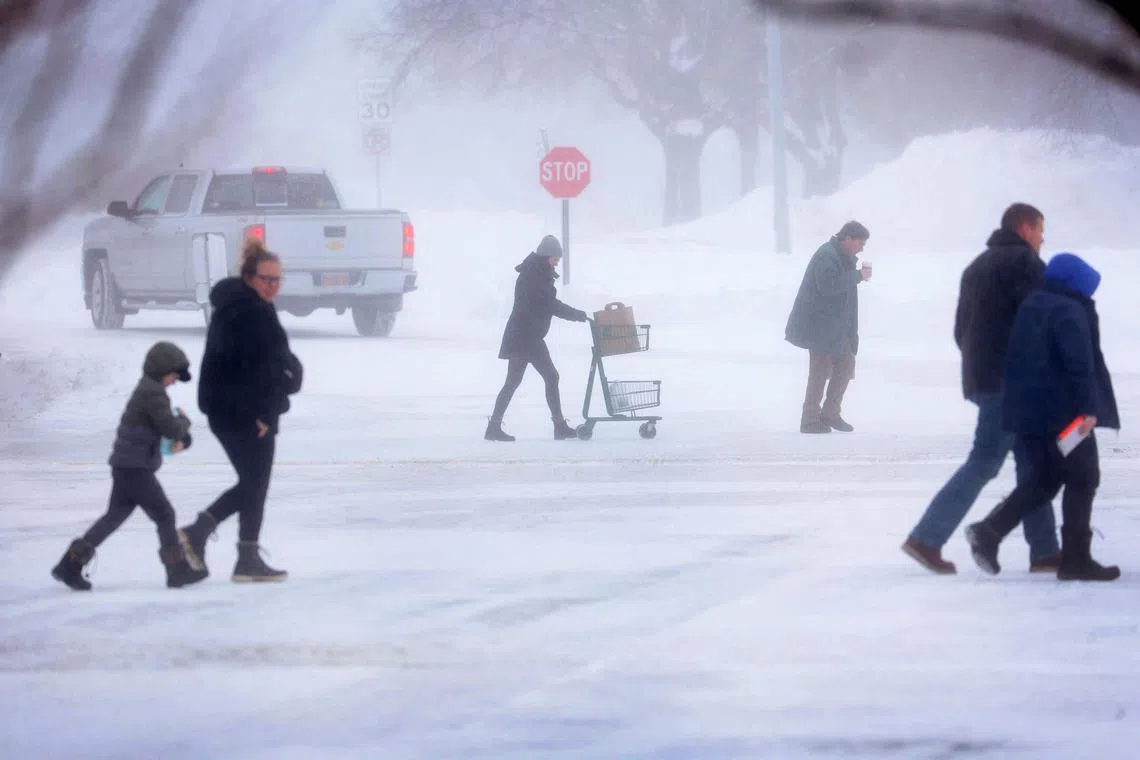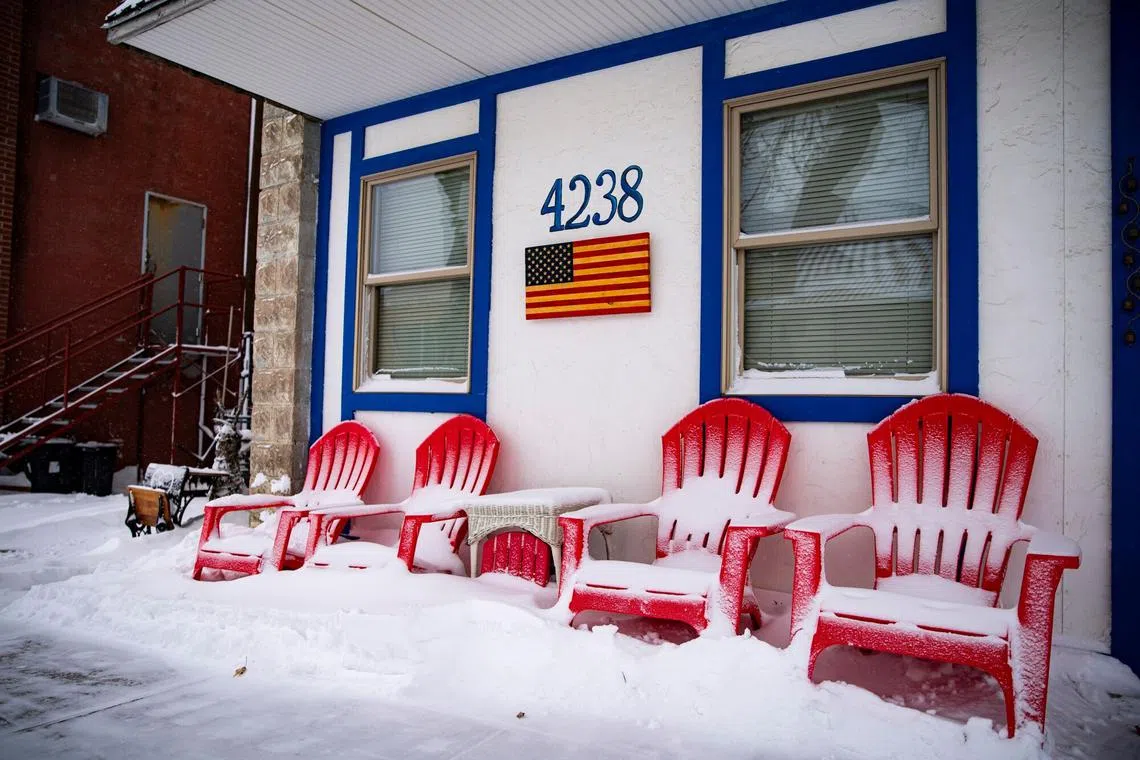Coast to coast, a brutal mix of snow, rain and bitter cold hits the US
Sign up now: Get ST's newsletters delivered to your inbox

A large portion of the United States are expected to face the coldest conditions of winter so far in the coming days.
PHOTO: BLOOMBERG
Follow topic:
WASHINGTON – Residents in Billings, Montana, woke up to a temperature of minus 32 deg C. In Des Moines, Iowa, home owners were digging out and facing wind gusts of 72kmh. Residents in Paterson, New Jersey, were evacuated from flooded homes. And communities near the Gulf Coast were preparing for a deep freeze.
More than 40 million Americans were under winter weather advisories on Jan 13, according to the US National Weather Service, from rain to high winds to heavy snow, and a large portion of the United States was expected to face the coldest conditions of winter so far in the coming days.
Here is a look at some of what is going on around the country.
The Midwest after the blizzard
Some Iowans spent the morning of Jan 13 bundling up and clearing their driveways and walkways; the temperature was minus 17 deg C at one point, with a wind chill of minus 43 deg C. In Des Moines, main thoroughfares were drivable but still covered in snow and hazardous. Many rural highways remained impassable.
The Iowa State Patrol said that from 12.30am on Jan 12 to 10am on Jan 13, it responded to 535 motorist assist calls and 86 crashes, none of which was fatal.
At a truck stop in Urbandale on the morning of Jan 12, Mr Amir Ford, a 24-year-old trucker who was hauling a load of glass doors, was trying to decide whether to continue his journey east to Chicago after a harrowing drive up the I-35 interstate highway.
“It’s treacherous. It’s cold, it’s icy, it’s bad,” he said, adding that he saw multiple vehicles in ditches along the route.
Early in the afternoon of Jan 13, officials in Iowa noted deteriorating conditions as more snow and high winds arrived. By late afternoon, blizzard conditions were reported in parts of the state.
Blizzard warnings remained in effect for much of the day in many states, including for parts of North Dakota, South Dakota and Nebraska. And areas of Michigan, Indiana and Minnesota faced additional snowfall.
Flooding in the north-east
The storm brought record-breaking water levels to parts of Maine’s coast on Jan 13, leading to extensive flooding in at least one area.
In South Portland, three century-old fishing shacks that had been recently restored were swept away in the storm surge that sent a wall of waves crashing onto Willard Beach on Jan 13.
The city had “just restored them to sturdy them up to make sure they stayed”, Lieutenant Kevin Theriault of the city’s police department said in an interview.
South Portland fire chief Phil Selberg said emergency workers helped a few people out of cars stuck in flood waters at the peak of the storm, but no injuries were reported.
Parts of New York, New Jersey and Connecticut have experienced nearly 5cm of rain since Jan 12, according to the weather service.
That precipitation, which lasted overnight into Jan 13, caused flooding in parts of New Jersey and led to evacuations of residents living near the Passaic River in Paterson and Little Falls.
In New York City, parts of the Henry Hudson Parkway, which runs along the west side of Manhattan, were closed because of flooding. Due to high winds, empty tractor-trailers and tandem trailers were temporarily banned on the Robert F. Kennedy Bridge.
As the Jan 13 storm started to wind down in New England, flooding brought on by heavy rain and high tides caused evacuations in Rhode Island and New Hampshire.
Plunging temperatures in the South
Temperatures in many areas began plummeting on Jan 13, and forecasters said that would continue into this week.
In Oklahoma, the weather service said “dangerously cold wind chills” – as low as minus 32 deg C – were to be expected at times, beginning late on Jan 13. Officials are urging residents to avoid outdoor activities.
Alabama could get up to 10cm of snow beginning on the night of Jan 14, forecasters said.
A winter storm watch is in effect for many counties in Tennessee from Jan 14 to the morning of Jan 16, with temperatures expected to drop on Jan 13 night to as low as minus 8 deg C and snow expected beginning on the evening of Jan 14, the National Weather Service said.
The governors of Louisiana and Arkansas declared states of emergency ahead of worsening conditions expected at the weekend.
“This will be dangerous cold, so the time to prepare is now!” the weather service in Little Rock warned.

The governors of Louisiana and Arkansas declared states of emergency ahead of worsening conditions expected this weekend.
PHOTO: AFP
In Amarillo, Texas, on Jan 13, it was minus 12 deg C by midday.
In the flat, dormant pastureland, ranchers have been feeding their cattle more in anticipation of the frigid weather, so they can stay warm, said Dr J.D. Ragland, a Texas A&M University agriculture expert in Randall County.
“Long episodes of extremely cold weather in our part of the world, we’re just simply not used to,” Dr Ragland said.
Snow and frigid temperatures in the West
Parts of Wyoming, Oregon, Northern California, Colorado, Nevada, Utah and Alaska were under winter storm warnings and wind chill warnings on Jan 13, with low temperatures and heavy snow expected in some areas and freezing rain possible.
Heavy snow was being reported in parts of Idaho.
In Sacramento, California, snow-covered roads in the Sierra Nevada caused “hazardous travel”, officials said.
In Montana, temperatures of minus 40 deg C or minus 46 deg C were possible on Jan 13. Flood advisories in some areas of the state also remained in effect.
Power outages and flight disruptions
In the Great Lakes region, just under 220,000 households were without power, according to PowerOutage.us, and in Oregon, more than 120,000 customers were without electricity.
Thousands of people across the north-east also experienced outages on Jan 13. In New England, most of the outages were in Vermont, Rhode Island and New Hampshire, where wind gusts of 48kmh or more had been predicted overnight.
In air travel, there were more than 1,200 flight cancellations and more than 4,300 flight delays
Cancellations were reported at airports including Chicago’s O’Hare Airport, Detroit’s Metro Wayne County Airport, Denver International Airport and New York’s Buffalo Niagara International Airport.
On Jan 12, the storm disrupted more than 10,000 flights across the country.
Impact on Iowa caucuses
This was the final weekend before the Iowa caucuses, and Republican presidential candidates are battling two forces: brutally cold temperatures and the threat of low voter turnout as they navigate the dangerous, icy roads and winds.
Candidates maintained a more regular schedule on Jan 13 after being forced to cancel many events on Jan 12.
Still, in Des Moines, the National Weather Service urged drivers to stay off the roads amid a storm that was once in a generation. A measurement at the Des Moines airport recorded 56.6cm of snow so far in the week, the most in a five-day period since 1941, according to the weather service.

Snow covered chairs ahead of the Iowa Caucus in Elk Horn, Iowa, US, on Saturday, Jan, 13, 2024.
PHOTO: BLOOMBERG
A different environment for the NFL playoffs
In New York, Governor Kathy Hochul announced on Jan 13 that the football playoff game in Buffalo between the Bills and the Pittsburgh Steelers, which had been scheduled for the afternoon of Jan 14, will be postponed to 4.30pm on Jan 15, citing “dangerous conditions”.
Forecasters in Erie County, which includes Buffalo, said that the snow totals could reach up to 0.6m and that blizzard conditions were possible over the weekend.
In Kansas City, Missouri, where the defending Super Bowl champion, the Chiefs, were set to host the Miami Dolphins in a wild-card playoff game on the night of Jan 13, temperatures were expected to be “well below zero” at kick-off, forecasters said.
The game was set to kick off at 8pm Eastern Time (8am Singapore time), with an expected temperature of minus 20 deg C, according to AccuWeather.
Still, Mr Tyler Shannon, 36, of Shawnee, Kansas, plans to be there, celebrating a friend’s birthday.
In addition to a heated vest and battery-powered heated socks, he planned to dress in plenty of layers, as well as ski goggles, “just in case”, he said by phone.
“As long as my face doesn’t freeze off, it’ll be great.” NYTIMES

